Jerusalem artichoke
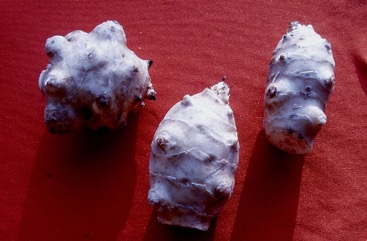
A temperate plant. Plants grow best when the temperature is 18°-26°C and frost free. They do best between 300 and 750 m altitude in the tropics. It needs light to medium well drained soils. Plants should be grown in an open sunny position. It is drought and frost resistant. It suits hardiness zones 7-9. In Sichuan.
Also known as:
Aardpeer, Aguaturma, Brahmokha, Cicoka, Cotufa, Csicsoka, Gerasole, Getnakhendzor, Girasole, Girsole, Gulia, Hartichuk, Hathipich, Hatichuk, Ju yu, Kiku-imo, Laška repa, Nyameres, Pataca, Patatas de cana, Pe-po-di, Ramons, Sari khendzor, Say erd, Setembres, Sevibanaghd, Sevik, Sunchoke, Topinambo, Topinambour, Totrepa, Yabani yerelmasi, Yer elmasi, Zemna yabalka
Synonyms
- Helianthus tomentosus Michaux
- Helianthus tuberosus var. albus Cockerell
- Helianthus tuberosus var. purpurellus Cockerell
Edible Portion
- Rhizome, Tubers, Root, Vegetable, Flowers
Where does Jerusalem artichoke grow?
Found in: Africa, Albania, Argentina, Armenia, Asia, Australia, Balkans, Bosnia, Britain, Bulgaria, Burundi, Canada, Caucasus, Chile, China, Croatia, Cuba, Egypt, Europe, Fiji, France, Georgia, Germany, Hungary, India, Indochina, Iraq, Italy, Japan, Korea, Laos, Luxembourg, Macedonia, Malaysia, Myanmar, Netherlands, New Zealand, North Africa, North America, Pacific, Papua New Guinea, PNG, Philippines, Romania, SE Asia, Serbia, Sicily, Slovenia, South Africa, Southern Africa, South America, Spain, Tasmania, Turkey, Uruguay, United States
Notes: Tubers contain inulin which can cause stomach wind in some people but is also tolerated by diabetics. Almost all Helianthus (60 species) in N and S America are edible.
Status: It is a commercially cultivated vegetable. Not commonly seen in Papua New Guinea.
Growing Jerusalem artichoke
Cultivation: Plants are grown from vegetative setts. These can be dormant for 7 months before they will grow. The flowers on the plants are removed to increase the yield. Plants can be grown from seed. Tubers are often sweetest after a frost.
Edible Uses: The tubers are eaten boiled or baked. They can be steamed, fried, pickled, pureed, or used in soups and casseroles. They can be eaten raw in salads. (They are suitable for people with diabetes) Roasted tubers are used as a coffee substitute.
Production: Harvesting can start after 3 months.
Nutrition Info
per 100g edible portion| Edible Part | Energy (kcal) | Protein (g) | Iron (mg) | Vitamin A (ug) | Vitamin c (mg) | Zinc (mg) | % Water |
|---|---|---|---|---|---|---|---|
| Tubers | 67 | 2 | 0.4 | - | 4 | - | 79 |
Jerusalem artichoke Photos

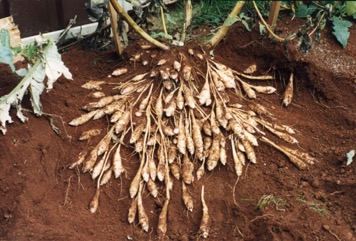
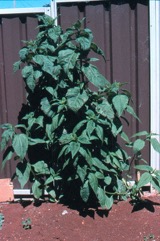
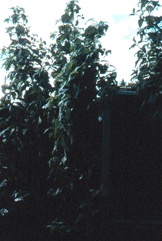
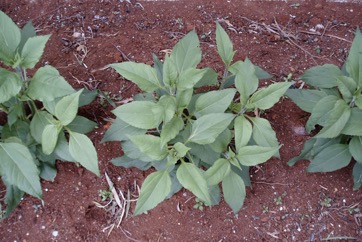
References
Altschul, S.V.R., 1973, Drugs and Foods from Little-known Plants. Notes in Harvard University Herbaria. Harvard Univ. Press. Massachusetts. no. 4828
Ambasta, S.P. (Ed.), 2000, The Useful Plants of India. CSIR India. p 260
Ari, S., et al, 2015, Ethnobotanical survey of plants used in Afyonkarahisar-Turkey. Journal of Ethnobiology and Ethnomedicine 11:84
Beckstrom-Sternberg, Stephen M., and James A. Duke. "The Foodplant Database." http://probe.nalusda.gov:8300/cgi-bin/browse/foodplantdb.(ACEDB version 4.0 - data version July 1994)
Bianchini, F., Corbetta, F., and Pistoia, M., 1975, Fruits of the Earth. Cassell. p 226
Bodkin, F., 1991, Encyclopedia Botanica. Cornstalk publishing, p 544
Bonet, M. A. & Valles, J., 2002, Use of non-crop food vascular plants in Montseny biosphere reserve (Catalonia, Iberian Peninsula). International Journal of Food Sciences and Nutrition (2002) 53, 225–248
Brouk, B., 1975, Plants Consumed by Man. Academic Press, London. p 69
Burkill, I.H., 1966, A Dictionary of the Economic Products of the Malay Peninsula. Ministry of Agriculture and Cooperatives, Kuala Lumpur, Malaysia. Vol 1 (A-H) p 1150
Bussman, R. W., et al, 2016, A comparative ethnobotany of Khevsureti, Samtskhe-Javakheti, Tusheti, Svaneti, and Racha-Lechkhumi, Republic of Georgia (Sakartvelo), Caucasus. Journal of Ethnobiology and Ethnomedicine (2016) 12:4
Bussman, R. W. et al, 2017, Ethnobotany of Samtskhe-Javakheti, Sakartvelo (Republic of Georgia), Caucasus. Indian Journal of Traditional Knowledge Vol. 16(1) pp 7-24
Cheifetz, A., (ed), 1999, 500 popular vegetables, herbs, fruits and nuts for Australian Gardeners. Random House p 69
Chen, B. & Qiu, Z., Consumer's Attitudes towards Edible Wild Plants, Ishikawa Prefecture, Japan. p 23 www.hindawi.com/journals/ijfr/aip/872413.pdf
Cordero, S. E., Abello, L. A., & Galvez, F. L., 2017, Plantas silvestres comestibles y medicinales de Chile y otras partes del mundo. CORMA p 180
Crawford, M., 2012, How to grow Perennial Vegetables. Green Books. p 123
Cundall, P., (ed.), 2004, Gardening Australia: flora: the gardener's bible. ABC Books. p 685
Denes, A., et al, 2012, Wild plants used for food by Hungarian ethnic groups living in the Carpathian Basin. Acta Societatis Botanicorum Poloniae 81 (4): 381-396
Dolina, K. & Luczaj, L., 2014, Wild food plants used on the Dubrovnik coast (south-eastern Croatia) Acta Soc Bot Pol 83(3):175–181
Duke, J.A., 1992, Handbook of Edible Weeds. CRC Press. p 108
Elias, T.S. & Dykeman P.A., 1990, Edible Wild Plants. A North American Field guide. Sterling, New York p 210
Esperanca, M. J., 1988. Surviving in the wild. A glance at the wild plants and their uses. Vol. 2. p 33
Facciola, S., 1998, Cornucopia 2: a Source Book of Edible Plants. Kampong Publications, p 39
French, B.R., 1986, Food Plants of Papua New Guinea, A Compendium. Asia Pacific Science Foundation p 21
Gouldstone, S., 1983, Growing your own Food-bearing Plants in Australia. Macmillan p 170
Gunes, S. et al, 2018, Survey of wild food plants for human consumption in Karaisali (Adana-Turkey). Indian Journal of Traditional Knowledge. Vol. 17(2), April 2018, pp 290-298 (As Helichrysum ?)
Hadfield, J., 2001, The A-Z of Vegetable Gardening in South Africa. Struik p 74
Hedrick, U.P., 1919, (Ed.), Sturtevant's edible plants of the world. p 339
Hermandez Bermejo, J.E., and Leon, J. (Eds.), 1994, Neglected Crops. 1492 from a different perspective. FAO Plant Production and Protection Series No 26. FAO, Rome. p18
Hussey, B.M.J., Keighery, G.J., Cousens, R.D., Dodd, J., Lloyd, S.G., 1997, Western Weeds. A guide to the weeds of Western Australia. Plant Protection Society of Western Australia. p 100
Hu, Shiu-ying, 2005, Food Plants of China. The Chinese University Press. p 735
Jackes, D. A., Edible Forest Gardens
Jardin, C., 1970, List of Foods Used In Africa, FAO Nutrition Information Document Series No 2.p 79
Kay, D.E., 1973, Root Crops, Digest 2, Tropical Products Institute, London, p 81
Kargioglu, M., et al, 2008, An Ethnobotanical Survey of Inner-West Anatolia, Turkey. Human Ecology 36:763-777
Kays, S. J., and Dias, J. C. S., 1995, Common Names of Commercially Cultivated Vegetables of the World in 15 languages. Economic Botany, Vol. 49, No. 2, pp. 115-152
Kiple, K.F. & Ornelas, K.C., (eds), 2000, The Cambridge World History of Food. CUP p 1793
Lazarides, M. & Hince, B., 1993, Handbook of Economic Plants of Australia, CSIRO. p 129
Licata, M., et al, 2016, A survey of wild plant species for food use in Sicily (Italy) – results of a 3-year study in four Regional Parks. Journal of Ethnobiology and Ethnomedicine 12:12
Lim, T. K., Edible Medicinal and Non-Medicinal Plants Volume 7 Flowers
Lim, T. K., 2015, Edible Medicinal and Non Medicinal Plants. Volume 9, Modified Stems, Roots, Bulbs. Springer p 45
MacKinnon, A., et al, 2009, Edible & Medicinal Plants of Canada. Lone Pine. p 352
Macmillan, H.F. (Revised Barlow, H.S., et al), 1991, Tropical Planting and Gardening. Sixth edition. Malayan Nature Society. Kuala Lumpur. p 359
Moerman, D. F., 2010, Native American Ethnobotany. Timber Press. p 259
Mukemre, M., et al, 2016, Survey of wild food plants for human consumption in villages of Catak, (Van-Turkey), Indian Journal of Traditional Knowledge. Vol. 15(2) pp. 183-191
Nedelcheva A., 2013, An ethnobotanical study of wild edible plants in Bulgaria. EurAsian Journal of BioSciences 7, 77-94
Norrington, L., & Campbell, C., 2001, Tropical Food Gardens. Bloomings Books. p 30
Nzigidahera, B., 2006, Assessment of Socio-cultural, Economic Characteristics and Livelihood of Riparian Population of the Kibira National Park. (Rukoma-Mutana locality). UNDP p 30
Paczkowska, G. & Chapman, A.R., 2000, The Western Australian Flora. A Descriptive Catalogue. Western Australian Herbarium. p 164
Petrova, I., et al, 2016, Five Edible Flowers – Valuable Source of Antioxidants in Human Nutrition. International Journal of Pharmacognosy and Phytochemical Research 2016; 8(4); 604-610
Pieroni, A., et al, 2005, Food for two seasons: Culinary uses of non-cultivated local vegetables and mushrooms in a south Italian village. International Journal of Food Sciences and Nutrition, 56(4): 245-272
Pieroni, A., et al, 2020, Wild food plants traditionally gathered in central Armenia: archaic ingredients or future sustainable foods? Environment, Development and Sustainability. Springer p 8
Plants for a Future database, The Field, Penpol, Lostwithiel, Cornwall, PL22 0NG, UK. http://www.scs.leeds.ac.uk/pfaf/
Polat, R., et al, 2015, Survey of wild food plants for human consumption in Elazig (Turkey). Indian Journal of Traditional Knowledge. Vol. 1(1): 69-75
Polat, R., et al, 2017, Survey of wild food plants for human consumption in Bingol, (Turkey). Indian Journal of Traditional Knowledge. Vol. 16(3) July 2017, pp. 378-384
Purseglove, J. W., 1968, Tropical Crops Dicotyledons, Longmans. p 68
Recher, P, 2001, Fruit Spirit Botanical Gardens Plant Index. www.nrg.com.au/~recher/ seedlist.html p 2
Redzic, S. J., 2006, Wild Edible Plants and their Traditional Use in the Human Nutrition in Bosnia-Herzegovina. Ecology of Food and Nutrition, 45:189-232
Redzic, S., 2010, Use of Wild and Semi-Wild Edible Plants in Nutrition and Survival of People in 1430 Days of Siege of Sarajevo during the War in Bosnia and Herzegovina (1992–1995). Coll. Antropol 34 (2010) 2:551-570
Rigat, M et al, 2009, Ethnobotany of Food Plants in the High River Ter Valley (Pyrenees, catalonia, Iberian Peninsula): Non-Crop Food Vascular Plants and Crop Food Plants with medicinal Properties. Ecology of Food and Nutrition, 48:303-327
Ruiters-Welcome, A. K., 2019, Food plants of southern Africa. Ph.D. thesis. Univ. of Johannesburg p 34
Saunders, C.F., 1948, Edible and Useful Wild Plants. Dover. New York. p 4
Schneider, E., 2001, Vegetables from Amaranth to Zucchini: The essential reference. HarperCollins. p 631
Smith, K., 1998. Growing Uncommon Fruits and Vegetables. New Holland. p 37
Sp. pl. 2:905. 1753
Tardio, J., et al, Ethnobotanical review of wild edible plants in Spain. Botanical J. Linnean Soc. 152 (2006), 27-71
Terra, G. J. A., 1973, Tropical Vegetables. Communication 54e Royal Tropical Institute, Amsterdam, p 50
Tindall, H.D., 1983, Vegetables in the tropics. Macmillan p. 86
Turner, N. J. et al, 2011, Edible and Tended Wild Plants, Traditional Ecological Knowledge and Agroecology. Critical Reviews in Plant Sciences, 30:198-225
USDA, ARS, National Genetic Resources Program. Germplasm Resources Information Network - (GRIN). [Online Database] National Germplasm Resources Laboratory, Beltsville, Maryland. Available: www.ars-grin.gov/cgi-bin/npgs/html/econ.pl (10 April 2000)
van Wyk, B., 2005, Food Plants of the World. An illustrated guide. Timber press. p 207
Wang, J. et al, 2013, A Study on the Utilization of Wild Plants for Food in Liangshan Yi Autonomous Prefecture. Plant Diversity and Resources. 35(4): 416-471
World Checklist of Useful Plant Species 2020. Royal Botanic Gardens, Kew